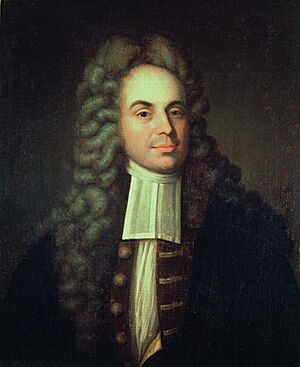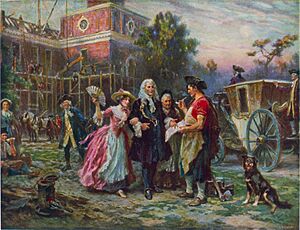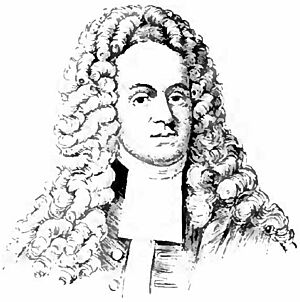Andrew Hamilton (lawyer) facts for kids
Quick facts for kids
Andrew Hamilton
|
|
|---|---|

An 1808 portrait of Hamilton by Adolf Ulrik Wertmüller
|
|
| 18th Speaker of the Pennsylvania House of Representatives | |
| In office 1736–1737 |
|
| In office 1741–1749 |
|
| Personal details | |
| Born | c. 1676 Kingdom of Scotland |
| Died | August 4, 1741 Philadelphia, Pennsylvania, British America |
| Spouse | Anne Brown Preeson |
| Profession | Lawyer |
| Signature | |
Andrew Hamilton (c.1676 – August 4, 1741) was a Scottish lawyer who moved to the American colonies. He settled in Philadelphia, a major city at the time. He is most famous for winning a very important court case for a printer named John Peter Zenger in 1735.
This case helped establish a key idea: that if what you say or write is true, you cannot be punished for libel (publishing false statements that damage someone's reputation). Hamilton famously argued that the press has "a liberty both of exposing and opposing tyrannical power by speaking and writing truth." His success in this case led to the saying "Philadelphia lawyer," meaning a very smart and skilled attorney.
Contents
Early Life and Moving to America
Andrew Hamilton was likely born in Scotland around 1676. We don't know much about his early family life or career there. He later moved to Accomac County, Virginia in British America around 1697. There, he continued to study law and worked as a teacher.
He married Ann Preeson in 1706. Her family was well-known, which helped Hamilton start his law practice. In 1708, he bought a large piece of land in Kent County, Maryland called "Henberry." He also kept a home in Virginia and had clients in both colonies.
Becoming a Prominent Lawyer
By 1712, Hamilton was a successful lawyer in Chestertown, Maryland. To boost his career, he traveled to London, England. He joined Gray's Inn, a famous legal society, and became a barrister (a type of lawyer) in 1712.
While in London, William Penn, the founder of Pennsylvania, hired Hamilton for a legal case. This began a long and friendly relationship between Hamilton and the Penn family. His work with the Penn family made him well-known.
In 1715, Hamilton was chosen to be a representative in Maryland's House of Delegates. He helped create a set of laws called the Act of 1715, which became the basis for Maryland's laws until the American Revolutionary War. Around this time, Hamilton moved to Philadelphia with his family.
Working for Pennsylvania
On September 7, 1717, Hamilton became the attorney-general of Pennsylvania. This meant he was the chief lawyer for the colony. He later joined the provincial council in 1721 but resigned in 1724 to help the Penn family with William Penn's will in London.
In 1722, a settler killed a Seneca man. This caused tension between the Native American tribes and the colonists. Hamilton, as Attorney-General, helped create a new law called the Judiciary Act of 1722. This law allowed the Chief Justice to act as a justice of the peace anywhere in the colony if needed, which helped deal with difficult situations like the Cartledge case.
In 1727, Hamilton was elected to the Pennsylvania Provincial Assembly. He became the Speaker (leader) of the Assembly in 1729 and was re-elected almost every year until 1739.
The Zenger Case: Fighting for Freedom of the Press
The most famous part of Hamilton's career was his defense of John Peter Zenger in 1735. Zenger was a printer in New York City who published a newspaper. He wrote articles saying that the governor was abusing his power. The attorney-general accused Zenger of seditious libel, which meant publishing things that criticized the government and caused unrest.
Zenger's original lawyers were removed from the case. So, a merchant named Mary Alexander suggested that Andrew Hamilton, who was a respected lawyer from outside New York, come to defend Zenger. Hamilton agreed to take the case for free.
Hamilton admitted that Zenger had printed the articles. However, he argued a new and bold idea: that if the statements in the newspaper were true, then Zenger should not be found guilty of libel. He told the jury that they were the judges of both the law and the facts.
Even though the court didn't want to hear evidence that Zenger's statements were true, Hamilton appealed directly to the jury. He asked them to consider what they knew about their daily lives and whether Zenger's articles were true. He argued that the old definition of libel, which didn't require the statements to be false, came from an unfair English court called the Star Chamber.
Hamilton's powerful speech convinced the jury, and they found Zenger "not guilty." People in New York and other colonies celebrated this decision. It was a huge step towards freedom of the press in America, meaning people could openly discuss the actions of public officials. Many people saw this as an early step towards the American Revolution.
Later Career and Public Service
From 1736 until his death, Hamilton guided a young lawyer named Benjamin Chew, who later became Attorney General of Pennsylvania. Hamilton also helped manage the province's system for printing paper money. In 1737, he was appointed a judge of the vice-admiralty court.
Building Independence Hall

In 1729, the people of Philadelphia wanted to build a state house for their government. Andrew Hamilton, along with Thomas Lawrence and John Kearsley, were chosen to plan the building, pick a location, and hire builders. Hamilton and his son-in-law, William Allen, bought the land that is now known as Independence Square. This is where Independence Hall stands today. Before this, the assembly met in private homes.
Hamilton is often given credit for designing Independence Hall, which was then called the Pennsylvania State House. However, it's more likely that he helped with the early plans, and another person, Edmund Woolley, was responsible for the final design and construction. The building was not finished until after Hamilton's death.
Land and Estates
For his legal work with William Penn's will, Hamilton received land from the Penn family in 1726 and 1729. He also bought more land, totaling 153 acres. This land became his estate called Bush Hill.
Bush Hill was a large country home in Philadelphia. It was later inherited by his son, James Hamilton, and then his nephew, William Hamilton. When Philadelphia was the temporary capital of the United States, Bush Hill was rented out as the vice-president's house. During the Yellow Fever Epidemic of 1793, some of its buildings were used as a hospital.
Hamilton also owned a large area of land called The Woodlands, located on the west side of the Schuylkill River. This land is now part of West Philadelphia.
Hamilton and his son James were also among the founders of Lancaster, Pennsylvania, in 1729. Hamilton owned the 500-acre tract where Lancaster was laid out around 1730. His son James later became the political leader of the county.
Later Life and Family
Andrew Hamilton's wife, Anne, is thought to have died around 1736. Hamilton himself died on August 4, 1741, at his home, Bush Hill. He was first buried on his property, but his remains were later moved to a mausoleum at Christ Church. Two days after his death, Benjamin Franklin published a tribute to Hamilton in his newspaper, the Pennsylvania Gazette.
Andrew and Anne Hamilton had several children. Their first child, Margaret, was born in 1709. Their first son, James Hamilton, was born around 1711. James later became a mayor of Philadelphia and a governor of the Pennsylvania colony. Their last son, also named Andrew Hamilton, was born in 1713.
In 1734, Margaret Hamilton married William Allen, who also became a mayor of Philadelphia and founded Allentown, Pennsylvania. Andrew Hamilton worked closely with his son-in-law. Together with James Hamilton, they bought the land for the state house (Independence Hall) and its surrounding yard.
Legacy
Andrew Hamilton's legacy is important for his role in establishing freedom of the press in America through the Zenger case. His work also contributed to the legal system and the development of major cities like Philadelphia and Lancaster. During World War II, a Liberty ship was named the SS Andrew Hamilton in his honor.
Images for kids
See Also
- Philadelphia lawyer
- John Peter Zenger
- Independence Hall




